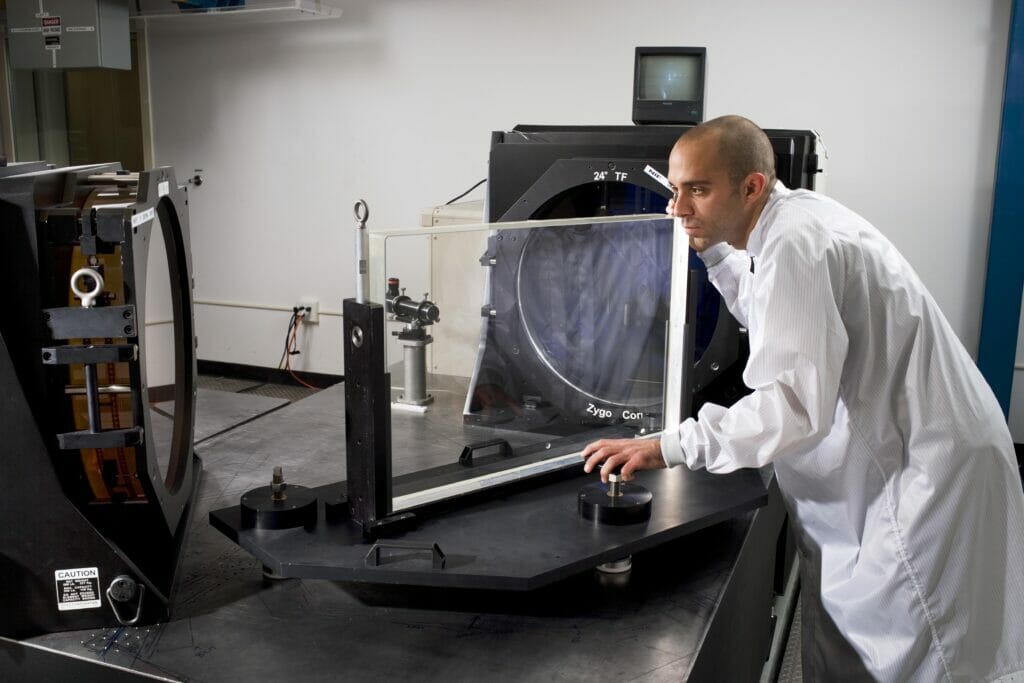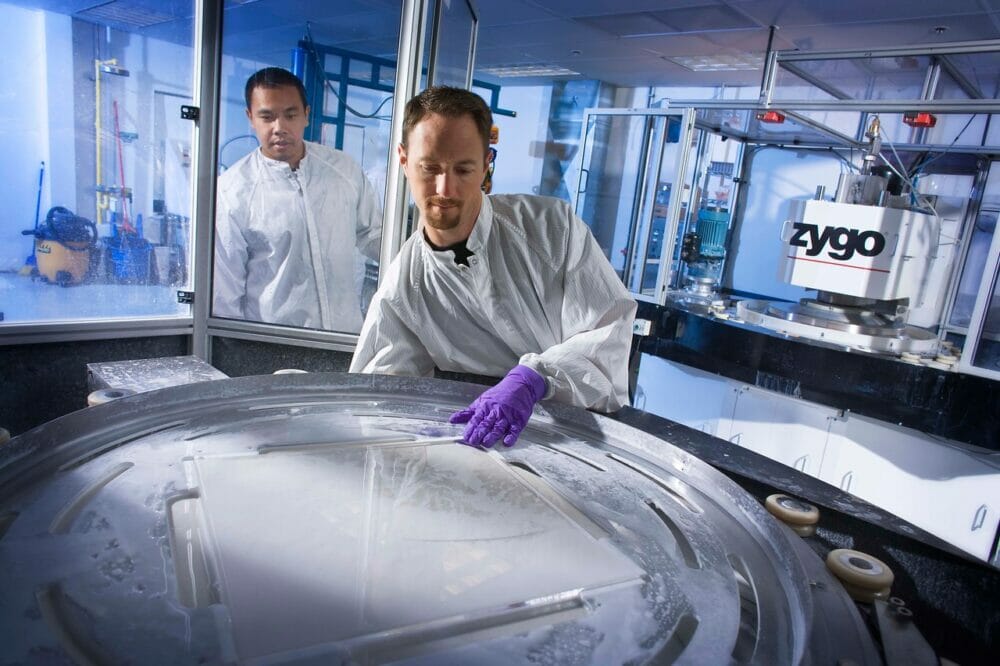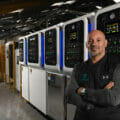Neil Curtis, DVP Sales, Marketing, and Service, Zygo Corporation
Inside the International Space Station (ISS) was a controlled symphony of switches, screens, and buttons, each contributing to the harmonious dance of human ingenuity and scientific progress.

Amidst this orchestrated complexity, an astronaut floated weightlessly, her eyes fixed on the universe beyond a window in the ISS’s cupola. Through the clear pane, she saw the awe-inspiring beauty of Earth, a swirling ball of blue and green suspended in the velvet embrace of space. It was a view that humbled the most intrepid of explorers, reminding them of their infinitesimal place in the grand tapestry of existence.
“I recall feeling an overwhelming sense of gratitude for the cupola windows, giving me the incredible privilege of gazing back at the awe-inspiring beauty of our planet”, says retired Astronaut Karen Nyberg, who flew on ISS Expedition 36/37 (May 28 to November 10, 2013). “I was not only captivated by the mesmerizing view, but also reminded of the remarkable workmanship and unwavering dedication of individuals who brought them into existence. The windows serve as our shield, protecting us from the unforgiving harshness of space. They provide both a breath-taking perspective and a vital barrier against the inhospitable environment. For that, I am eternally grateful to the skilled visionaries who made them possible.”
Many brilliant minds had worked in unison to achieve such perfection. In that moment, Nyberg glimpsed the unspoken collaboration of countless engineers and scientists who had transformed the impossible into reality. The windows embodied the unwavering determination of humanity to push boundaries, to reach beyond what was known, and to grasp the secrets of the universe.
She remained transfixed, realizing that the windows were not just simple panes of glass, but a testament to the relentless pursuit of knowledge, the unwavering dedication to exploration, and the indomitable spirit of humanity. In that solitary moment, suspended between worlds, Nyberg felt an unyielding sense of wonder and gratitude for the remarkable precision, ingenuity and expertise that went into the building of the ISS in its entirety, and these windows in particular, that at the same time protected the crew but also gave them the ability to view the impossible beauty of space.
_________________
This was the first time that Karen Nyberg and Zygo had come into such close proximity, as it was Zygo that had polished and tested these windows. Zygo is renowned the world over for the creation of innovative optics solutions and precision metrology instruments, many used in the most exacting of environments, space.
Mighty oaks from little acorns grow, and some 10 years later, Zygo is proud to announce that Nyberg has partnered with Zygo as its Brand Ambassador.
At the heart of the collaboration between suppliers such as Zygo with customers requiring precision windows — like the one Nyberg looked through on the ISS — is trust. Trust serves as the foundation for a successful partnership in product development for such critical applications. It signifies a belief in the supplier’s expertise, reliability, and commitment to delivering high-quality products that meet stringent standards.
In the context of optics for the ISS, trust entails confidence that Zygo will employ rigorous quality control measures, adhere to precise specifications, and consistently deliver components that withstand the rigors of space. The reliability and dependability of Zygo’s products are crucial factors that must be trusted implicitly, as any compromise in the windows’ performance could have far-reaching consequences for space missions, astronauts’ safety, and the success of scientific endeavours.
For components used on the ISS and the astronauts on board, the demand is perfection, as without perfection missions and even lives are at stake. The consequences of failure are catastrophic, so the requirement to work alongside companies with similarly high standards is key, as is ultimate trust in their part of the overall mission. Zygo, and astronauts on the ISS like Nyberg, set the bar when it comes to standards in their respective fields, and the real interest lies in how such companies, individuals, and teams working at the cutting edge operate in terms of leadership and development.
Vision and Purpose
From the get-go, there are numerous synergies obvious between the team at Zygo and the teams of astronauts that work on board the ISS. All require an intelligent view of leadership and bring high performance teams together to push boundaries, and where projects like the ISS stimulate innovation “to go boldly where no one has gone before”, companies like Zygo stimulates innovation to make ever more bleeding-edge customer facing technology solutions. Nyberg gives an insight into the leadership issues at play when working to become an ISS astronaut.
“ As part of astronaut training, we attended something called the National Outdoor Leadership School (NOLS). One of the key takeaways from the school, and something that I think is relevant to organizations like Zygo (and indeed throughout business) is that part of success when flying in space is to learn not just ‘leadership’ but also ‘followership’. The key is knowing when to switch from one to another. You need an in-built situational awareness that tells you when to lead and when to follow. There are some personalities that have a hard time being followers. They want to take control, and a lot of the work undertaken at NOLS was designed to tame these people. As so often is the case, operational success comes from nurturing a collaborative team approach, pooling talent, with anyone in a leadership role having the skills to recognize individual talents and aptitudes and to orchestrate a plan that brings all these aptitudes together to optimize outcomes.”

“Once at NOLS, a group of us were on a winter camping expedition. The team were on skis, and we would have a leader for the day, a navigator for the day, and a trail breaker for the day. The trail breaker’s job was to get information from the navigator about where we were supposed to go, and then decide the best way to get there. For some people it was really hard to let the trail breaker undertake this task without interjecting and taking control. We without a doubt were taught that there really is no ‘I’ in ‘TEAM’.”
Good leadership obviously plays a crucial role in driving organizations towards success, fostering innovation, and cultivating a positive work culture. To delve into the essence of excellent leadership, you need to examine the core values that motivate a company like Zygo and the astronauts that work on the ISS, and from this it is possible to glean valuable insights into the key factors that contribute to effective leadership.
Nyberg picks up the story, “From my perspective, at the heart of excellent leadership (apart from knowing when to lead and when to follow) lies a compelling vision and a clear sense of purpose. Strong organizations always strive for remarkable achievements and exceptional leaders communicate their vision effectively, instilling a shared sense of purpose among their teams.”
“An exceptional leader fosters a culture of innovation and continuous improvement. In my view, Zygo exemplifies this by embracing cutting-edge technologies and promoting a growth mindset. Zygo’s dedication to research and development drives the creation of state-of-the-art metrology and optics solutions. Projects like the ISS which I was privileged to be part of necessitate constant innovation. Effective leaders encourage experimentation, risk-taking, and learning from failures to drive progress and stay ahead of the curve.”
Collaboration, Team Building, and Teamwork
Successful leaders understand the value of collaboration, team building, and teamwork. Zygo and the innovative customers it works with recognize that diverse teams with complementary skills and perspectives can achieve extraordinary results. Zygo actively promotes cross-functional collaboration to leverage the collective expertise of its employees. It also promotes a collaborative partnership relationship with its customers. Exceptional leaders foster a supportive environment that encourages teamwork, trust, and open communication.
Jennifer Hellberg as the Division Vice President (DVP), Business Unit Manager at Zygo says, “Good leadership encompasses a strong ethical foundation and a sense of responsibility towards stakeholders. Zygo demonstrates its commitment to ethical conduct and social responsibility in various ways, but perhaps most importantly by adhering to stringent quality standards, ensuring the delivery of reliable products to its customers. Projects such as the provision of windows for the ISS place the utmost importance on safety protocols and environmental stewardship. Exceptional leaders lead by example, emphasizing integrity, transparency, and accountability.”
Once a team is in place, good leaders are able to motivate and encourage team members to exceed expectations. Nyberg gives an interesting insight into this from her time on the ISS.
“There was one instance when two of my colleagues were undertaking a spacewalk. My role as ‘Intra-Vehicular Activity’ (IVA) leader was to help get them suited up and depressurize and repressurize the airlock to get them in and out of the station. Once they were outside working, over the comms I heard one astronaut talking about water getting into his helmet, and the situation quickly escalated to the point where it was necessary to abort the spacewalk. We needed to get him in quickly as the situation was becoming critical. I knew one colleague present was as conversant with the airlock routine as I was, so I flew off to locate the commander to advise him of the emergency. Then I went back and worked with Mission Control about the best way to get the astronaut out of his suit quickly, sticking closely to ‘suit doffing’ protocols to avoid injuries. Soon all three Russian cosmonauts came down to help, not just the commander. As IVA leader, my role was just to make sure everything ran smoothly, as everyone was trained and kind of knew what needed to be done instinctively. The one time I had to ‘lead’ was when I saw one crew member go to take off the helmet which would have caused a huge pressure release and potentially ruptured eardrums. Other than that, leadership did not mean control. The key was to keep intervention to a minimum and let the team operate while just keeping a watchful eye out. It truly is sometimes teamwork that makes the dream work, a lesson for all that collaboration and teamwork are very often the key to success.”
“When working on the ISS, fundamentally there are rules and protocols for everything. These protocols are in place and learned by all team members so that in each and every situation, there is a procedure to follow. However, the key to good leadership and good teamwork is to know when, in unexpected situations, decisions need to be made that are not necessarily in line with the rule book. Rigid structures are the least strong and you need to have an inherent flexibility in there to be able to adapt to circumstances. The situation we found ourselves in as a team when the helmet started to fill with water was totally unexpected. So, we had to adapt to circumstances, lean on protocols as far as possible, but also work together to adapt to these particular circumstances. And then the key for any organization is to learn and adapt processes to ensure either the problem doesn’t happen again, or to have tried and tested plans in place. Continuous learning and continuous improvement.”
Learning & Development
Outstanding leaders prioritize the learning and development of their teams, empowering them to reach their full potential. Zygo invests in employee growth through training programs, mentorship initiatives, and knowledge sharing platforms. Zygo’s technical expertise is enhanced through continuous learning, while astronauts working on the ISS undergo rigorous training to acquire the necessary skills for space exploration. Effective leaders in these organizations encourage personal and professional growth, creating a culture of continuous learning and nurturing future leaders.
The symbiotic relationship between Zygo and its customers showcases the power of collaboration and shared goals. Zygo’s precision metrology instruments and optical solutions contribute to the success of projects like the ISS and therefore the safety of the astronauts on board. Zygo’s technologies help in areas such as satellite fabrication, optical system alignment, and surface metrology. Conversely, the challenging requirements of such projects as the ISS push Zygo to develop cutting-edge solutions, fostering innovation and advancing its technological capabilities. This interdependence highlights how fruitful partnerships can fuel excellence and mutual growth.
Nyberg concludes, “I am excited about my partnership with Zygo. As a company that pursues excellent leadership, Zygo is a beacon of inspiration. Zygo’s core values of vision, purpose, innovation, collaboration, ethics, and learning match well with my background and training to become an astronaut. Leaders that embrace these principles create an environment that encourages growth, fosters innovation, and cultivates a positive organizational culture. Zygo and my training to be an astronaut, culminating in my time on the ISS, provide valuable lessons on excellent leadership. In our own ways we strive to reach new heights and tackle complex challenges and, to do this effective leadership becomes paramount.”
Hellberg finishes up, “Remember, leadership is a journey of continuous growth and development. By adopting the principles discussed in this article and learning from the success stories of organizations like Zygo and astronauts like Karen, leaders can inspire their teams, drive meaningful change, and make a lasting impact.”







